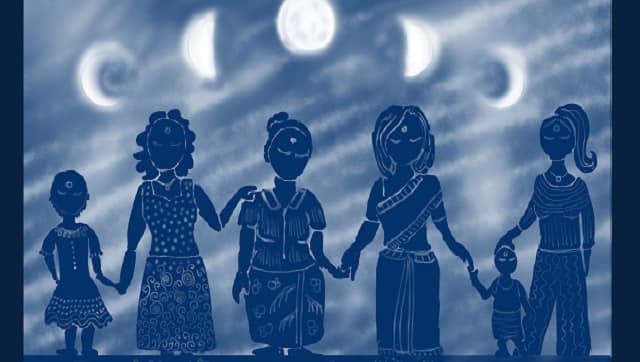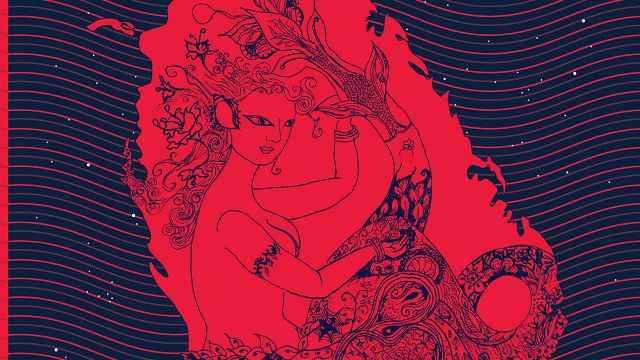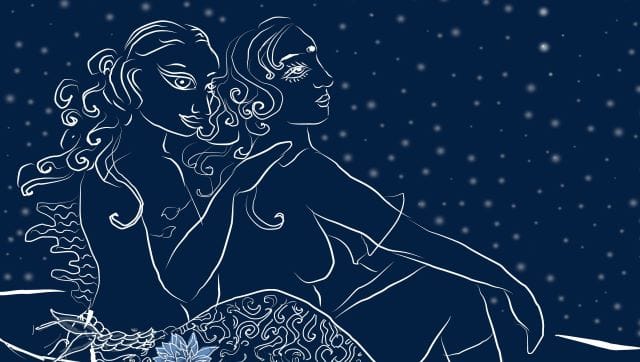On a full moon night in October 2017, author Sharanya Manivannan entered the Kallady lagoon in Mattakalappu (Batticaloa, Sri Lanka). It is believed that on such nights, if you dip a paddle into the water and hold the dry end to your ear, you can hear mysterious sounds from the deep. For about an hour, the navigators took the boat to different spots on the lagoon, so she could hear the strange sounds inside the water. “There were tonal variations at the different spots, and that they are distinctly located suggests that something static (like shell clusters, rather than something dynamic like a school of fish) may produce them,” she says. “I was aware that this was an unusual experience in myriad ways. For instance, during the civil war, such joyrides were too dangerous to undertake — more mysteriously still, it seemed that the singing fish did not sing during many of those years,” she says. It is these sounds and mysteries that Manivannan explores in her graphic novel, Incantations Over Water. The book is part of a duology on Ila of the Kallady lagoon, accompanying a picture book for children, Mermaids in the Moonlight. In Incantations Over Water, Ila the mermaid is the narrator, and offers what the author calls a “self-portrait without mythology." Incantations is a lyrical book, with prose that reads like poetry, and sentences that stay with you long after the pages are turned. The story has history. There is a sprinkling of magic, of old-time lore that encapsulates mythology, politics, identity, and longing. Manivannan has illustrated the book herself, creating visuals of the lagoon and Ila that are beautiful and stirring. The author has been drawing and painting since her teens. With the Ila duology, she knew that her storytelling was going to not only be textual. “The visual nature of the mermaid motif in Batticaloa played a part in my decision to explore this medium. The meen magal (mermaid in Tamil) is such a part of the ambience in a very visual way there,” she says. [caption id=“attachment_10306351” align=“alignnone” width=“640”]  Illustration in Incantations Over Water[/caption] Excerpts from an interview: What is your fascination with mermaids? Like many children, I liked mermaids. I was around five when I watched Disney’s The Little Mermaid [1989]. But a full-fledged fascination with them only happened in adulthood. To this, I would strongly credit seeing the mermaid symbol around Batticaloa for the first time, at the age of 27. It was really quite extraordinary to me that the meen magal was everywhere. My mother had told me when I was a child that there was a mermaid in her hometown who sang in the lagoon on full moon nights, but I had not thought about this in a long time, and seeing that the motif was so pronounced in the town’s public facades inspired my curiosity, and drew me in. A few years after that first visit, I gathered the courage to go back to Batticaloa entirely because of the mermaids. By telling myself I was chasing their stories, I was able to undertake the risk of journeying to a place that could break my heart. Incantations is a deeper and darker book than Mermaids in the Moonlight. What were you hoping to convey about the region’s history and loss through it? There is very little literature available in English, in translation or otherwise, that is set in Batticaloa. Many people from outside the island, as well as some in the diaspora, don’t understand what a conflation it is to say “the North East,” when the Tamil North and the Tamil East of the island are culturally and otherwise rather distinct from each other — and even have a long history of rivalry. In a sense, some of my work fulfils for me the “write the book you want to read” directive — I would like for the East to have more representation in literature, the arts, politics and more, and am glad contribute to that expansion. When I began to go to Batticaloa to explore the meen magal motif and the lack of folklore, I was bequeathed more than I could have imagined. I would use the word “found,” but it was more than that — I felt like I had received, not only sought, and this feeling fuelled the way in which Nilavoli and her mother interact in Moonlight — there is a subtle, deeper inheritance given to the child through the stories shared on that boat ride. Learning about the culture and history of the place illuminated so much to me about myself, my family, and the region. When you grow up within a culture, you aren’t necessarily really taught it, and aspects of non-mainstream cultures are invariably eroded when families try to raise their children in new milieus. I’ll give you an example: my mother and her siblings, their generation, largely chose patriarchal lifestyle and religious modes. So they did not like to discuss their grandmother, who had left her husband in the late 1920s and lived by herself, with her husband retaining their only surviving child (my grandfather, who was raised by his father’s mother). It was only during my mermaid quest in Batticaloa that I found out how my great-grandmother had managed that, a feat that is difficult even in a South Asian metropolis today. She was from the dominant Mukkuvar fishing caste, which practiced matrilineal and matrilocal kinship systems. She owned land, and when her marriage to a Jaffna man ended, she chose to move to that land. For a long time, I believed she had abandoned her son, but my grandfather told me last year that his father had refused to give him up; losing custody of the child was the compromise his mother made for her freedom. This extraordinary story had always been hinted at, and always sidestepped, in my family. I found out about it in detail in Batticaloa from people I am not related to, whom I am indebted to. Brahminical aspiration, in every regard, had rendered that story a taboo in my family. In fact, when I located my great-grandmother’s land (unused, and under unknown ownership) and visited it in 2019, my mother and her siblings weren’t interested in hearing about it at all. My grandfather, however, was thrilled to see the video I took there, of the place where his mother had lived out her willful and unusual life. These learnings — the sense that so much was deliberately concealed, and so much was lost, and so much cannot be erased because the truth has a way of shining through — informed Incantations in particular, and other prose that I am working on. [caption id=“attachment_10306361” align=“alignnone” width=“640”]  Illustration in Incantations Over Water[/caption] What was your creative process for this book? During your research, did you find mermaid stories in oral history? I didn’t find mermaid stories in Batticaloa oral tradition, and I spoke to a cross-section of generous people (academics, fisherpeople, scientists, writers and more) before I was able to determine this. But mermaid stories exist in oral lore across the world, and have been widely recorded as well. Some of these stories are famous, while others are little-known — a combination of both feature in my books. My creative process, in this order, was: research, writing, drawing. The research for both books overlapped, of course. Research comprised mainly of reading extensively, and talking to people in Batticaloa both formally and informally. I wrote and drew Moonlight first, followed by Incantations. Funnily enough, Batticaloa’s mermaids haven’t had much of a literary place either, despite their strong visual presence, which most visitors would notice. There are a few allusions — in his novel Amnesty, Aravind Adiga uses them as a mere exotica trope (but there are other things about his reading and rendering of Batticaloa people and life that are very astute), and Shiromi Pinto’s Plastic Emotions refers to the lagoon as being cursed.
But to the best of my knowledge, no author had really ventured into exploring the meen magal as their central subject — which was strange to me as a reader, but very exciting from a creative perspective.
You have written about being highly aware of the risk of cultural appropriation. How did you approach that? For Moonlight in particular, I was worried about how to represent a diverse selection of mermaid stories around the world while also bringing to the young reader a sense that these stories came from certain places, and were traditionally told by certain people, who have certain histories. This was quite difficult to do. This is why the book begins and ends on a note of encouragement towards further readings and explorations. Moonlight also brings in stories about human beings who spend large amounts of aquatic time, whether in Rameshwaram or Jeju Island or Borneo. It is a far less magical book than Incantations, so its rooting in the mundane world, and my concern for respectful retellings that were age-appropriate, both shaped it. By the time I got to writing Incantations, I had worked through some of the fear that had earlier held me back, and found a way to tell the stories I wanted to with reverence — Ila’s reverence for her kin across the waters of the water. Marine life itself, rather than the human, and the creatures of the deep began to become very important to Ila’s ethos. I’ve found interesting the number of people — adults — who have told me they had no idea about mermaid stories beyond Hans Christian Andersen’s and Disney’s rendition until they read Moonlight. But the only mermaid story I had to make up was Ila’s — the rest already existed, swimming in the lore and literature of the world. How does your identity — a member of the traumatised Tamil diaspora from the island — shape your storytelling? It shapes everything — so of course, it would shape my storytelling too. For me, it took a long time for me to be able to give myself permission to create work about the particular culture and cultural memory that is mine. A part of this was from a sense of inadequacy — something that I sense a great deal in other diasporics, and which can manifest in myriad ways (some destructive, some creative). That feeling did not go away for me until I began to spend time properly in Colombo and Batticaloa in my 30s, and cultivated meaningful relationships with the places themselves and with people who live there. I am grateful to be able to create the work that I had longed my whole life, or at least my whole career, to create. [caption id=“attachment_10306371” align=“alignnone” width=“640”]  Illustration in Incantations Over Water[/caption] You once mentioned you write for women. How does that affect your writing style or research or the characters you create? If I think about a reader at all, I tend to assume her to be a woman. In the making of my work, I tend to be keenly aware of elisions and silences, and of the androcentricity of many narratives. I try to write in ways that puts the female voice and experience at the centre instead — or at least ways that stake a claim to the margins to which that voice had been relegated, and thereby shift the centre itself. You write so that you can honour your ancestral culture. What other stories can we expect from you in the future? When I was 19, I began writing a novel called Constellation of Scars — excerpts of which have been published in various places over the years. Over the last 17 years, this story has drawn me back to it again and again, even with gaps of years between working on it, and with seven other books created and published in the meanwhile. This novel is largely set in Batticaloa, between the years 1929 and 2006, and it is a story about intergenerational trauma and intergenerational love, with the backdrop of a rapidly changing landscape — the traditional matrilineal culture begins to lose ground, the British colonial era ends, ethnic unrest turns into ethnic conflict. I am quite far into this manuscript now, and my hope is that it will be my next book (although manuscripts have a tendency to jump the queue, and surprise me). I also have a couple of short story collections at varying stages of progress: one is about journeys in, around, and into or out of the island. The other, which I quite recently started, is more mermaid tales set in Batticaloa. Joanna Lobo is an independent journalist from Goa, who enjoys writing about food, her Goan heritage, and other things that make her happy. By the side, she co-owns a food publication: But First, Food and sends out a freelancing newsletter: It’s All Write.


)
)
)
)
)
)
)
)
)



